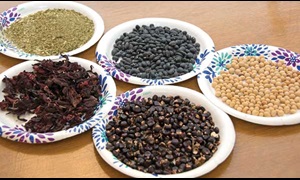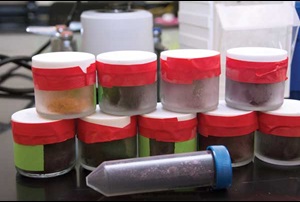The Promise of Plants to Reduce Chronic Disease
INSIDE ACADEMIA
In the battle against cancer and other noncommunicable chronic diseases, one factor has emerged as the best method to reduce their incidence: prevention. Perhaps the simplest way to prevent or lower the risk of certain chronic diseases is through diet and nutrition. Some of the most nutritious foods on the planet are plant foods, and research studies have long indicated an inverse association between a high consumption of plant foods and chronic diseases. Plant foods contain thousands of bioactive compounds that, when consumed, catalyze a variety of changes within the body, interacting with cells, enzymes, hormones, and DNA and playing a role in controlling gene expression and cell changes that lead to chronic disease. But some plant foods and their components are more effective at battling disease than others. Researchers at the University of Illinois at Urbana-Champaign (UIUC) are identifying compounds in plant foods that are so remarkable, the chemopreventive and anti-inflammatory properties they exhibit may have the potential to foster an era free from chronic disease. Their discoveries bring new meaning to the maxim “Let food be thy medicine and medicine be thy food.”
Demystifying the Potency of Plants

 From her early years as a biochemical engineer, Elvira Gonzalez de Mejia, a professor in the department of food science and human nutrition at UIUC, understood that plant foods contain bioactive compounds that could promote health and prevent disease. “I started realizing throughout my studies that there is much more than just nutrition [in foods],” de Mejia says. “Nutrients are very important, of course, to keep us working physiologically, but foods contain much more than just nutrients. Foods contain other compounds that are not nutrients, and they play a very key role in human health.” In plant foods, those other compounds are phytochemicals and peptides. Phytochemicals are plant compounds that are not essential nutrients (i.e., fats, carbohydrates, proteins, vitamins, and minerals). Plants produce these chemicals as secondary metabolites to defend against environmental stressors such as weeds, fungi, insects, and ultraviolet rays. And peptides are short chains of amino acids; they are smaller than proteins. “Proteins are formed by amino acids, but when you break proteins into short fragments, the fragments are called peptides,” says Diego Luna-Vital, a postdoctoral fellow at UIUC who works with de Mejia in her laboratory. “Depending on the disease, there are some amino acid compositions that are more likely to interact with enzymes related to diabetes, cancer, obesity, inflammation, etc.” Over the years, research has suggested that certain phytochemicals may have the same tendencies. Vegetables, fruits, grains, and legumes contain thousands of phytochemicals, including carotenoids such as lutein and lycopene, polyphenols such as anthocyanins and catechins, and glucosinolates such as sulforaphane, that have been associated with a range of health benefits.
From her early years as a biochemical engineer, Elvira Gonzalez de Mejia, a professor in the department of food science and human nutrition at UIUC, understood that plant foods contain bioactive compounds that could promote health and prevent disease. “I started realizing throughout my studies that there is much more than just nutrition [in foods],” de Mejia says. “Nutrients are very important, of course, to keep us working physiologically, but foods contain much more than just nutrients. Foods contain other compounds that are not nutrients, and they play a very key role in human health.” In plant foods, those other compounds are phytochemicals and peptides. Phytochemicals are plant compounds that are not essential nutrients (i.e., fats, carbohydrates, proteins, vitamins, and minerals). Plants produce these chemicals as secondary metabolites to defend against environmental stressors such as weeds, fungi, insects, and ultraviolet rays. And peptides are short chains of amino acids; they are smaller than proteins. “Proteins are formed by amino acids, but when you break proteins into short fragments, the fragments are called peptides,” says Diego Luna-Vital, a postdoctoral fellow at UIUC who works with de Mejia in her laboratory. “Depending on the disease, there are some amino acid compositions that are more likely to interact with enzymes related to diabetes, cancer, obesity, inflammation, etc.” Over the years, research has suggested that certain phytochemicals may have the same tendencies. Vegetables, fruits, grains, and legumes contain thousands of phytochemicals, including carotenoids such as lutein and lycopene, polyphenols such as anthocyanins and catechins, and glucosinolates such as sulforaphane, that have been associated with a range of health benefits.

 While studies on potency and potential of these plant compounds have been performed before, de Mejia and her laboratory team are internationally renowned for their research on bioactive compounds present in plant foods that are common in ethnic cuisine. To identify plant foods and compounds that may enhance human health, de Mejia and her team use a three-pronged approach: 1) perform chemical analysis and characterization of food compounds, 2) determine the biological effects of these compounds, and 3) reveal the cellular and molecular mechanisms of action through which bioactive compounds reduce the risk of chronic disease. Through this approach, the de Mejia laboratory has identified certain phenolic compounds and food peptides in teas, legumes, herbs, and certain vegetables and fruits that stand out from the rest in terms of their potency against disease. “I became interested in phytochemicals in certain plant foods that are not common in many other products. People are so healthy in those regions of the world where they are drinking certain types of ethnic teas and green tea. For many years, we studied traditional and nontraditional ethnic teas and the chemical composition of these teas,” de Mejia reveals. “There was a very interesting collection of beans in Mexico that grew under arctic conditions that no one had studied before. That was part of my initial research: learning what those [bean] peptides do to the body and learning not just their chemical composition but also their effectiveness against some of the most important chronic diseases.” Through in vitro and in vivo studies performed on yerba mate and hibiscus teas, Ardisia compressa tea, red and purple corn, soybeans, and beans commonly consumed in Latin America, the de Mejia laboratory has identified bioactive phytochemicals and peptides that may have powerful effects in preventing and/or eliminating cancer, obesity, and type 2 diabetes.
While studies on potency and potential of these plant compounds have been performed before, de Mejia and her laboratory team are internationally renowned for their research on bioactive compounds present in plant foods that are common in ethnic cuisine. To identify plant foods and compounds that may enhance human health, de Mejia and her team use a three-pronged approach: 1) perform chemical analysis and characterization of food compounds, 2) determine the biological effects of these compounds, and 3) reveal the cellular and molecular mechanisms of action through which bioactive compounds reduce the risk of chronic disease. Through this approach, the de Mejia laboratory has identified certain phenolic compounds and food peptides in teas, legumes, herbs, and certain vegetables and fruits that stand out from the rest in terms of their potency against disease. “I became interested in phytochemicals in certain plant foods that are not common in many other products. People are so healthy in those regions of the world where they are drinking certain types of ethnic teas and green tea. For many years, we studied traditional and nontraditional ethnic teas and the chemical composition of these teas,” de Mejia reveals. “There was a very interesting collection of beans in Mexico that grew under arctic conditions that no one had studied before. That was part of my initial research: learning what those [bean] peptides do to the body and learning not just their chemical composition but also their effectiveness against some of the most important chronic diseases.” Through in vitro and in vivo studies performed on yerba mate and hibiscus teas, Ardisia compressa tea, red and purple corn, soybeans, and beans commonly consumed in Latin America, the de Mejia laboratory has identified bioactive phytochemicals and peptides that may have powerful effects in preventing and/or eliminating cancer, obesity, and type 2 diabetes.
When Plants Attack!
To determine the effectiveness of various plant foods against gastrointestinal cancers—which constitute about 20% of all cancer diagnoses in the United States—de Mejia and her team looked at bioactive compounds in teas made from yerba mate, Ardisia compressa, and hibiscus. “The chemical composition of yerba mate is completely different than Camellia sinensis, [the plant from which black, green, and oolong teas are produced]. It has a very high concentration of caffeine,” de Mejia says. “It has a high concentration of saponins, and all of these compounds together with other minor phenolics, which are quercetin and others that are very important biologically speaking, are in this tea.” Her findings were similar when she investigated the chemical composition of Ardisia compressa. “We found very unique phenolic compounds in Ardisia compressa that are not present in most teas,” de Mejia says. She and her research team determined that teas made from yerba mate, Ardisia compressa, hibiscus, and Camellia sinensis had significant effects on cancers of the colon and liver—either suppressing the proliferation of cancer cells directly or inhibiting the action of an enzyme involved in the regulation of DNA replication.
The de Mejia research team has also found that compounds in beans, soybeans, purple corn, red corn, and berries have antagonistic effects on gastrointestinal cancers. Through his studies on azufrado beans, bayo beans, black beans, and pinto beans, Luna-Vital has determined that “each bean has its own beauty and its own health benefits, but in general, any type of bean is beneficial.” His research explains how bioactive peptides in certain beans can stymie the progression of colon cancer. “We recorded for the first time the effects of peptides from beans in colon cancer cells. There are some peptides that can reach the colon, and we were interested to see what happens because we know from previous studies that beans actually reduce the progression of colon cancer. [Beans] are a protein-rich food, so we were sure that some [peptides] were playing some role,” Luna-Vital reveals. “We found five main peptides in a particular extract, and out of these peptides, two were potent in in inhibiting the cancer cells. However, the other three [peptides] that didn’t kill the cells had a protective effect on normal colon cells, protecting them from ulcerative stress.”
Soybeans also figure prominently in possessing bioactive peptides; in particular, soybeans (and some cereal grains) contain a peptide called lunasin. De Mejia and her research team conducted in vitro studies and in vivo studies in animals and found that lunasin in soybeans has anti-inflammatory and anticancer properties. The potency exhibited by lunasin in preventing the metastases of colon cancer cells is especially notable. “It is very impressive. We studied the mechanism of action and learned about the receptors on the surface of cancer cells that attract lunasin, which allows lunasin to enter cancer cells and kill them and prevent the mobility of these cells throughout the body,” de Mejia asserts. “I think human studies of lunasin in cancer patients is the next step because it is very, very powerful.”
 Also effective against colon cancer are natural pigments from purple corn and red corn. “In this laboratory, we have looked at anthocyanins a lot because they are these pigments in various plants, and there is a lot of effort in the food industry to use natural pigments,” says Candice Mazewski, a doctoral food science student at UIUC who works in the de Mejia laboratory. “Some of the mechanisms that we’ve looked at were inducing apoptosis within the cancer cells, so the programmed cell death that helps kill cancer. … We also looked at some of the other mechanisms that lead to the progression such as angiogenesis, which is when blood vessels grow to a tumor and allow it obtain nutrients so that it can continue to grow and eventually spread.” In her studies conducted in vitro, Mazewski’s findings indicate that anthocyanin extracts from both red and purple corn inhibit the proliferation of colon cancer cells. She would like to follow up with ex vivo studies, which would involve testing the effects of plant extracts and pure compounds on tumor tissues excised from human colon-cancer patients.
Also effective against colon cancer are natural pigments from purple corn and red corn. “In this laboratory, we have looked at anthocyanins a lot because they are these pigments in various plants, and there is a lot of effort in the food industry to use natural pigments,” says Candice Mazewski, a doctoral food science student at UIUC who works in the de Mejia laboratory. “Some of the mechanisms that we’ve looked at were inducing apoptosis within the cancer cells, so the programmed cell death that helps kill cancer. … We also looked at some of the other mechanisms that lead to the progression such as angiogenesis, which is when blood vessels grow to a tumor and allow it obtain nutrients so that it can continue to grow and eventually spread.” In her studies conducted in vitro, Mazewski’s findings indicate that anthocyanin extracts from both red and purple corn inhibit the proliferation of colon cancer cells. She would like to follow up with ex vivo studies, which would involve testing the effects of plant extracts and pure compounds on tumor tissues excised from human colon-cancer patients.
Saponins present in yerba mate, ginseng and other herbs; soybeans, peas and other legumes; and certain vegetables are bioactive compounds that possess detergent qualities (they foam when mixed with water). De Mejia and her team have performed research that indicates that saponins may improve immune function, lower cholesterol levels, and slow the growth of cancer cells. Other plant compounds under investigation in the de Mejia lab have proven effective against another form of gastrointestinal cancer: pancreatic cancer. “Pancreatic cancer is a very devastating disease because it doesn’t alert you, and by the time you know you have it, it’s too late,” de Mejia emphasizes. “Our studies with pancreatic cancer, apigenin, and luteolin [two kinds of flavonoids] are really very surprising. The inhibition of certain enzymes—in particular, glucokinase—was a key pathway in killing pancreatic cancer cells.” And the team’s studies on fermented blueberries and blackberries reveal that the phenolic compounds they contain inhibit enzymes involved in the development of type 2 diabetes.
The grand purpose of conducting these in-depth studies is to identify which plant foods and plant food compounds may have the most significant impact in preventing disease and enhancing human health. Once identified and verified, these foods and bioactive compounds can be used to develop healthy products that can lessen the global burden of chronic disease. “The implications of our studies are important not just for the food industry but also for global consumers,” de Mejia concludes. “We are contributing to the better health of many consumers around the world.”
Toni Tarver is senior technical editor of Food Technology magazine ([email protected]).

